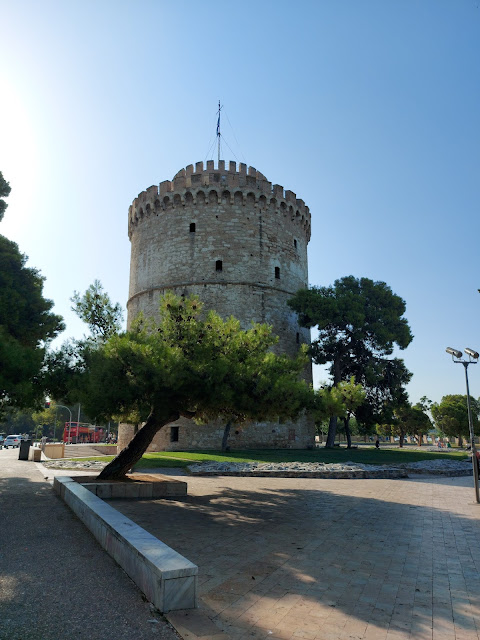 |
| The Orizontes Roof Garden Restaurant at the hotel had great food and wine. Wine made from local Xinomavro grapes went well with strawberry and roe butter. |
 |
| The smoked eel and eggplant appetizer |
 |
| Beef sofigado |
 |
| The White Tower of Thessaloniki was constructed by the Ottomans in the 15th century. |
 |
| The Tower was used as a prison in addition to a fortress/garrison. A massacre of Janissaries took place there in the 1800s. |
 |
| There are nice views at the top of the Tower. |
 |
| Art in the park |
 |
| The Archaeological Museum of Thessaloniki has some great finds. The oldest writing in the region, from the 7th century B.C., says "mine." |
 |
| The band is back together. |
 |
| A warrior with a golden death mask from ~520 B.C., from before the unification of Macedonia. |
 |
| A mosaic of Dionysus from the 200s A.D., when Romans ruled the region. |
 |
| Oxen figurines from a child's grave from around 100 B.C. - 100 A.D. |
 |
| Gilded silver grave decorations of the Greek Gods from ~330 B.C., around the time of Philip II and Alexander the Great. |
 |
| A golden wreath worn in life and death to symbolize importance in Macedonian society. |
 |
| The Derveni Crater, a 4th century urn first used to mix wine with water, and later used to hold the deceased's ashes. |
 |
| The Museum of Byzantine Culture picks up where the Archaeological Museum leaves off. The mosaic signs are a nice touch. |
 |
| Nice designs! |
 |
| Byzantine clothes |
 |
| A tomb from the 4th century A.D., the period where many residents of Thessaloniki converted to Christianity. |
 |
| These slabs are from the 10th-11th centuries. How aesthetics change. |
 |
| Impressive jewelry from the 9th-10th centuries |
 |
| The museum also had some interesting modern art. |
 |
| A significant portion of downtown Thessaloniki is built over Roman Emperor Galerius's palace from the 4th century. |
 |
| We ate lunch near some of the ruins at Ουζερί Λόλα. The squid stuffed with feta cheese was a highlight. |
 |
| The dessert was great too! |
 |
| The Arch of Galerius commemorates his victory over the Sassanid Persians in the Battle of Satala, a zenith of Roman power in the East. The Arch was dedicated in 303 A.D. |
 |
| The Rotunda of Galerius was built at the same time. Originally intended to be his mausoleum, it was converted into a Christian church. |
 |
| The mosaics in the Rotunda are still in good condition considering they are over 1000 years old. |
 |
| One of few surviving reminders many of Thessaloniki's churches were converted into mosques during Ottoman rule. |
 |
| We also visited Ataturk's childhood home next to the Turkish Embassy. He was born in Thessaloniki; the city was ceded from the Ottoman Empire to the Greeks during his lifetime. |
 |
| Security is pretty tight at the Museum. To get in you have to go through a gate like you are entering the Embassy compound. |




No comments:
Post a Comment